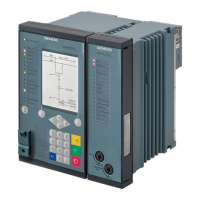Detailed information about the functionality can be found in the chapters 7.2.4.11 Dead Time for Operating
Modes With Tripping , 7.2.4.16 Circuit-Breaker Readiness and Circuit-Breaker Condition and 7.2.4.13 Evolving-
Fault Detection During Dead Time.
Parameter: Evolving-fault detection
This parameter is not important and cannot be set if you use the ADT function (automatic reclosing function
with adaptive dead time).
•
Default setting (_:6601:108) Evolving-fault detection = with trip
With the Evolving-fault detection parameter, you can determine which criteria is used to recognize
an evolving fault. The actual effect of the recognized evolving fault on the automatic reclosing function can be
set with the parameter described below Response to evolv. faults .
Evolving faults are short circuits, which occur after switching off a short circuit during dead time.
You can find detailed information about evolving-fault detection in the chapter 7.2.4.13 Evolving-Fault Detec-
tion During Dead Time.
Parameter Value Description
with trip
Evolving faults are recognized if an operate indication occurs during the dead
time. Thus, it does not matter if the tripping-protection function is configured
for the start of the automatic reclosing function or not.
The pickup of a protection function without an operate indication does not lead
to evolving-fault detection.
with pickup
Evolving faults are detected if during the dead time a protection function
configured for the automatic reclosing function start is picked up or if an
external pickup is detected through a binary input.
For applications with 1-/3-pole tripping, Siemens recommends the setting with trip if the system is
adequately interconnected.
If multiple individual lines in a row form a total transmission path, the setting with pickup may be better
suitable. With this setting, you can prevent 2 lines following each other from switching to 1-pole in different
conductors during evolving faults. The consequence of this fault would be the remainder of a single conductor
in the dead time for the overall transmission path. This is particularly important if power plants are coupled
through the overall transmission path.
Parameter: Response to evolv. faults
This parameter is not important and cannot be set if you use the ADT function (automatic reclosing function
with adaptive dead time).
•
Default setting (_:6601:109) Response to evolv. faults = blocks 79
With the Response to evolv. faults parameter, you can determine how the automatic reclosing func-
tion reacts to recognized faults.
You can find detailed information about the automatic reclosing function for faults in the chapter
7.2.4.13 Evolving-Fault Detection During Dead Time.
Parameter Value
Description
blocks 79
The automatic reclosing function is immediately blocked until the disconnec-
tion of the fault.
For blockings through faults during the 1-pole dead times, you can force a 3-
pole trip command through the automatic reclosing function if the you set the
parameter 3-pole operate by 79 to yes .
strt. evol.flt.dead
time
After the 3-pole trip command to clear up the fault, the automatic reclosing
function starts a new 3-pole automatic reclosing function cycle with the set
Dead time aft. evolv. fault .
Protection and Automation Functions
7.2 Automatic Reclosing Function
SIPROTEC 5, High-Voltage Bay Controller, Manual 589
C53000-G5040-C015-9, Edition 11.2017

